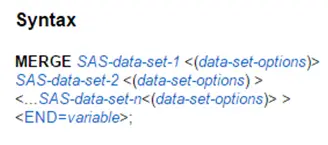
x will have output 1 if the By-variable exists in data-set1, 0 otherwise. Two new column x and y will be generated. By default, when match-merging, the DATA step combines all of the observations in all of the input data sets. It is an exploratory analysis of the influence of the proportion.

MERGE By: BY in Merge statement is similar to JOIN in PROC SQL: DATA data-set The next example is a little more complex than the preceding ones. If you instead use multiple SET statements, the final data set will have minimun number of obs. of final data set will be equal to the maximum number of obs. MERGE statement would keep all the observations from the data sets. reads the descriptor information of each data set named in the SET statement and then creates a program.
#SAS DATA MERGE UPDATE#
Its function is to update a master file, in the form of a SAS dataset, by applying transactions (observations from another SAS dataset). PROC APPEND does not require the base data set to exist before creation. Life saver tip for comparing PROC SQL join with SAS data step merge 14 By Charu Shankar on SAS Learning Post Topics Learn SAS Programming Tips Phew That tip alone was a life saver, said a student in one of my SAS SQL classes. MERGING : Merging is nothing but combining two or more SAS datasets horizontally In one to one merging dataset are not required to be sorted But for match. The UPDATE statement performs a special type of merge.The FORCE options causes SAS to drop the extra variables in DATA, and then to issue a warning message to the log.


The SET statement and the MERGE statement in SAS are basically used to combine the dataset in vertical and horizontal manner, respectively. On the other hand, in Python, there are some data formats used for data handling and visualization. Also, SAS cannot change any variable information in the descriptor portion of the BASE. In SAS, mainly data are manipulated and analyzed in SAS dataset format. In PROC APPEND step, SAS does not read the observations in the BASE.Syntax: PROC APPEND BASE=base-data-set DATA=append-data-set


 0 kommentar(er)
0 kommentar(er)
